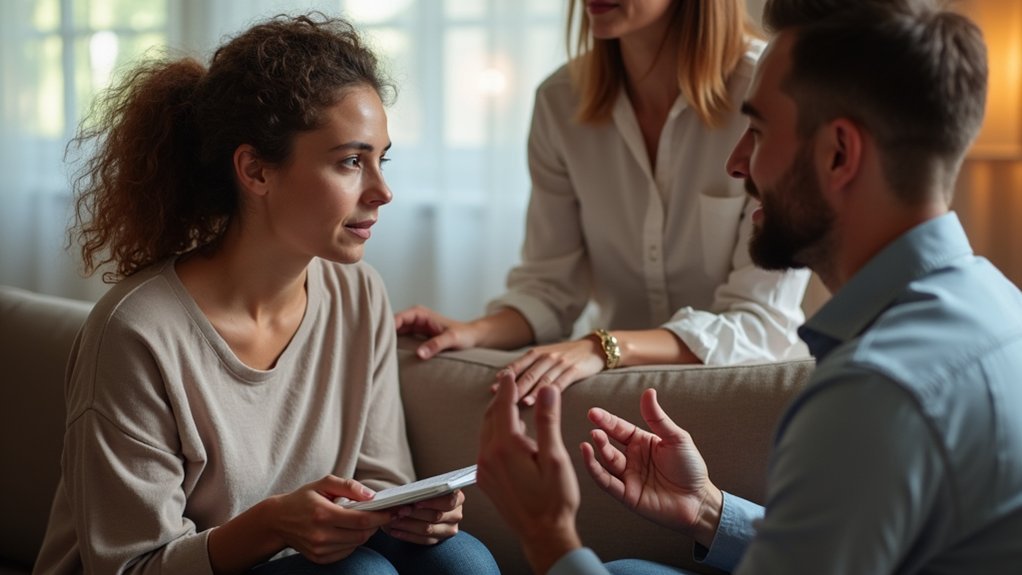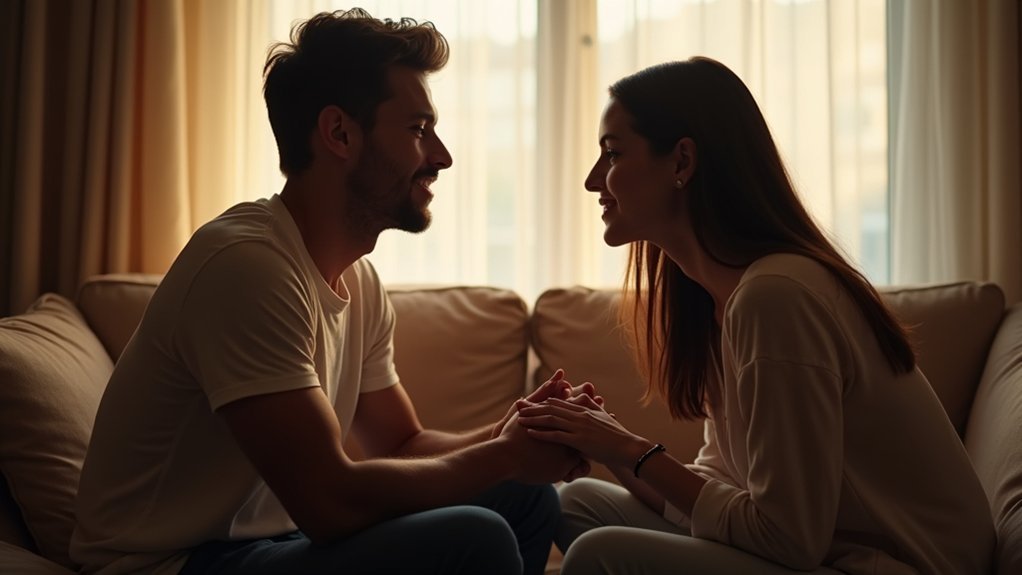You’ve likely experienced moments when communication with your partner feels like steering through a maze blindfolded. Active listening isn’t just about hearing words—it’s about understanding the emotional landscape beneath them. Imagine transforming your relationship through intentional, compassionate communication techniques that break down walls and rebuild connection. These exercises aren’t magic, but they’re powerful tools that can shift how you and your partner truly see and hear each other. Want to discover how?
Key Takeaways
- Utilize the “Mirroring Exercise” where partners take turns sharing experiences while the listener paraphrases back their understanding without judgment or interruption.
- Practice the “No-Interruption Dialogue” where each partner speaks uninterrupted for 5-10 minutes about their feelings, with the other maintaining attentive body language and eye contact.
- Implement daily “Emotion Check-In” sessions where couples use ‘I’ statements to express vulnerabilities, creating a safe space for authentic emotional communication.
- Conduct the “Sandwich Method” communication technique, where constructive feedback is framed between positive affirmations to reduce defensiveness and promote empathetic listening.
- Engage in structured “Active Listening Worksheets” that guide partners through reflective questioning, helping them validate each other’s emotions and perspectives systematically.
Understanding Active Listening

While communication is the cornerstone of any healthy relationship, active listening represents a powerful skill that can transform how couples interact and understand each other. Active listening goes beyond merely hearing words; it’s a deliberate communication technique that involves fully focusing on your partner’s message, maintaining eye contact, and creating a safe space for emotional expression. By practicing reflective listening, you’ll develop deeper empathy and emotional connections that strengthen your relationship’s foundation.
The core of active listening lies in your ability to truly comprehend your partner’s perspective without interrupting or judging. You’ll validate their feelings through affirming body language and paraphrasing their thoughts, which builds trust and intimacy. These communication skills help couples navigate complex conversations with greater understanding and compassion.
Benefits of Active Listening in Relationships

Understanding the mechanics of active listening sets the stage for appreciating its profound impact on relationships. By embracing active listening, you’ll reveal powerful benefits that transform communication dynamics.
| Benefit | Impact | Relationship Outcome |
|---|---|---|
| Empathy | Deeper Understanding | Enhanced Emotional Intimacy |
| Trust | Safe Communication | Reduced Conflict |
| Clarity | Precise Comprehension | Collaborative Problem-Solving |
| Connection | Emotional Validation | Stronger Partnership |
Active listening fosters a collaborative environment where both partners feel heard and valued. It’s not just about hearing words, but truly understanding the emotions beneath them. Through intentional listening, you’ll build trust, reduce misunderstandings, and create a supportive space for authentic communication. By practicing active listening, you’re investing in a healthier, more resilient relationship where both individuals can express themselves without fear of judgment, ultimately deepening your emotional and physical connection.
Common Communication Barriers

How often do communication barriers silently erode the foundation of your relationship? Listening challenges can emerge from various sources, creating significant communication issues that prevent meaningful connection. External distractions like technology and noise disrupt your ability to practice active listening skills, while defensiveness transforms potential dialogue into confrontational exchanges.
Emotional triggers frequently hijack your capacity for open communication, causing reactive responses that overshadow your partner’s genuine message. Misunderstandings arise from unspoken expectations, creating invisible walls between partners. Without consistent practice active listening becomes increasingly difficult, leaving couples trapped in cycles of miscommunication.
Recognizing these barriers is the first step toward developing effective communication exercises. By acknowledging and addressing these challenges, you’ll create opportunities for deeper understanding and more authentic connection.
Mirroring Exercise: A Step-by-Step Guide

Communication barriers often create distance between partners, but the Mirroring Exercise offers a powerful technique to bridge those gaps. This active listening method helps couples develop deeper empathy and mutual understanding through precise verbal communication.
- Learn to reflect your partner’s emotions without judgment
- Practice focused listening that validates their experience
- Transform potential relationship problems into opportunities for connection
During the exercise, one partner shares their thoughts while the other listens intently, then repeats back exactly what was said. This approach guarantees clarity and demonstrates genuine engagement with your partner’s body language and verbal expression. By switching roles, both individuals practice articulating feelings and confirming understanding. The Mirroring Exercise isn’t just a communication skill—it’s a pathway to rebuilding trust and strengthening emotional intimacy in your relationship.
Validating Emotions Without Judgment

Three critical steps can transform how partners validate each other’s emotions without judgment, creating a foundation of genuine empathy and emotional safety. Active listening becomes powerful when you focus on understanding your partner’s feelings without trying to fix them.
| Step | Action | Purpose |
|---|---|---|
| Listen | Reflect Feelings | Reinforce Partner’s Experience |
| Acknowledge | Validate Emotions | Build Emotional Intimacy |
| Empathize | Communicate Effectively | Increase Relationship Satisfaction |
When you use phrases like “I can see why you feel that way,” you’re demonstrating deep emotional validation. This approach helps partners feel heard and understood, reducing potential conflicts. By practicing these techniques, you’ll create a safe space where both individuals can express themselves authentically, leading to higher levels of connection and mutual understanding in your relationship.
Paraphrasing Techniques for Better Understanding
Validating your partner’s emotions sets the stage for deeper understanding, and paraphrasing emerges as a powerful tool to enhance communication. By actively listening and restating your partner’s message in your own words, you create a supportive environment that reduces misunderstandings and builds emotional intimacy.
- Use phrases like “So what you’re saying is…” to confirm your understanding
- Practice full engagement with your partner’s emotional expression
- Transform communication through intentional, reflective listening
Paraphrasing requires concentrated effort and genuine commitment to understanding. When you skillfully reframe your partner’s words, you demonstrate that you’re truly hearing them. This communication exercise helps couples move beyond surface-level dialogue, encouraging deeper connection and mutual respect. By consistently practicing these techniques, you’ll develop more nuanced communication skills that foster trust and emotional closeness.
Non-Verbal Communication Cues
Although words form the foundation of dialogue, the unspoken language of non-verbal cues often reveals the deepest emotional truths in couples’ interactions. In couples therapy, your nonverbal communication can dramatically enhance active listening and emotional connection.
| Non-Verbal Cue | Communication Impact |
|---|---|
| Eye Contact | Builds trust, signals engagement |
| Open Posture | Demonstrates receptiveness |
| Facial Expressions | Reveals underlying emotions |
| Body Proximity | Indicates emotional availability |
Creating a Safe Listening Environment
When couples prioritize creating a safe listening environment, they lay the groundwork for meaningful and transformative communication. By dedicating undivided attention to each other, partners can feel more comfortable sharing their true feelings and perspectives.
- Choose a quiet space that minimizes distractions
- Confirm both partners are emotionally prepared
- Set clear boundaries for respectful dialogue
Active listening requires creating a safe environment where nonverbal communication signals genuine engagement. You’ll want to maintain eye contact, use attentive body language, and demonstrate openness to your partner’s perspective. Regular check-ins help you adjust and maintain an open and honest communication dynamic. By intentionally crafting a supportive atmosphere, you’ll foster deeper understanding and connection, allowing both partners to express themselves without fear of judgment or interruption.
Practice Exercises for Couples
Because effective communication requires deliberate practice, couples can transform their relationship dynamics through targeted active listening exercises. One partner can initiate a stress-reducing conversation by scheduling focused discussions where each takes turns speaking without interruptions. Implementing the Sandwich Method allows for expressing needs between positive statements, fostering empathy and good communication.
Daily or weekly check-ins provide opportunities to mirror each other’s words, confirming understanding and building trust. By using ‘I’ statements, partners can share physical and emotional experiences without blame. These exercises encourage expressing gratitude and creating a safe space for vulnerability. Active listening isn’t just about hearing words; it’s about deeply understanding your partner’s perspective, validating their feelings, and strengthening your emotional connection through intentional communication.
Transforming Conflict Through Effective Listening
Steering relationship conflicts requires more than just speaking; it demands a deliberate commitment to understanding your partner’s perspective through active listening. By embracing empathetic communication, you can transform potential conflicts into opportunities for deeper connection.
- Active listening isn’t about winning an argument, but understanding your partner’s emotional landscape
- Effective listening creates a safe space for vulnerable and honest communication
- Communication exercises help you develop mutual understanding and respect
Through structured listening techniques, you’ll learn to validate emotions, paraphrase effectively, and demonstrate genuine empathy. These active relationship exercises enable you to navigate disagreements with compassion, reducing misunderstandings and fostering emotional intimacy. When you truly listen—not just hear—you’re investing in a more robust, resilient partnership that can withstand challenging conversations and emerge stronger.
Frequently Asked Questions
What Is the Couples Active Listening Exercise?
You’ll practice active listening by taking turns sharing feelings, reflecting back what you’ve heard, and using nonverbal cues to enhance empathy, break communication barriers, and strengthen your relationship’s emotional dynamics with trust and understanding.
How to Practice Active Listening in Relationships?
Like a bridge connecting two hearts, you’ll master communication techniques through active listening. By validating emotions, using reflective responses, and embracing nonverbal cues, you’ll enhance trust, resolve conflicts, and deepen intimacy in your relationship.
What Are Some Couple Therapy Exercises?
You’ll enhance communication styles through exercises like mirroring, where you’ll practice emotional validation, share experiences, and develop empathy. These structured techniques help resolve conflicts, build trust, and align relationship goals through intentional, supportive feedback exchanges.
What Is the 40/20-40 Process?
Communication’s the heartbeat of love. You’ll navigate relationship dynamics using the 40/20-40 technique, balancing emotional awareness and effective feedback by dedicating time for individual expression, collaborative discussion, and empathy-driven conflict resolution.
Conclusion
Let active listening be the bridge that connects your hearts, transforming communication from a battlefield to a sanctuary of understanding. By embracing these techniques, you’ll weave a tapestry of empathy, trust, and deep connection. Your relationship can bloom like a resilient garden, nurtured by compassionate listening and mutual respect. Commit to these practices, and watch your love grow stronger with each vulnerable, intentional conversation.



